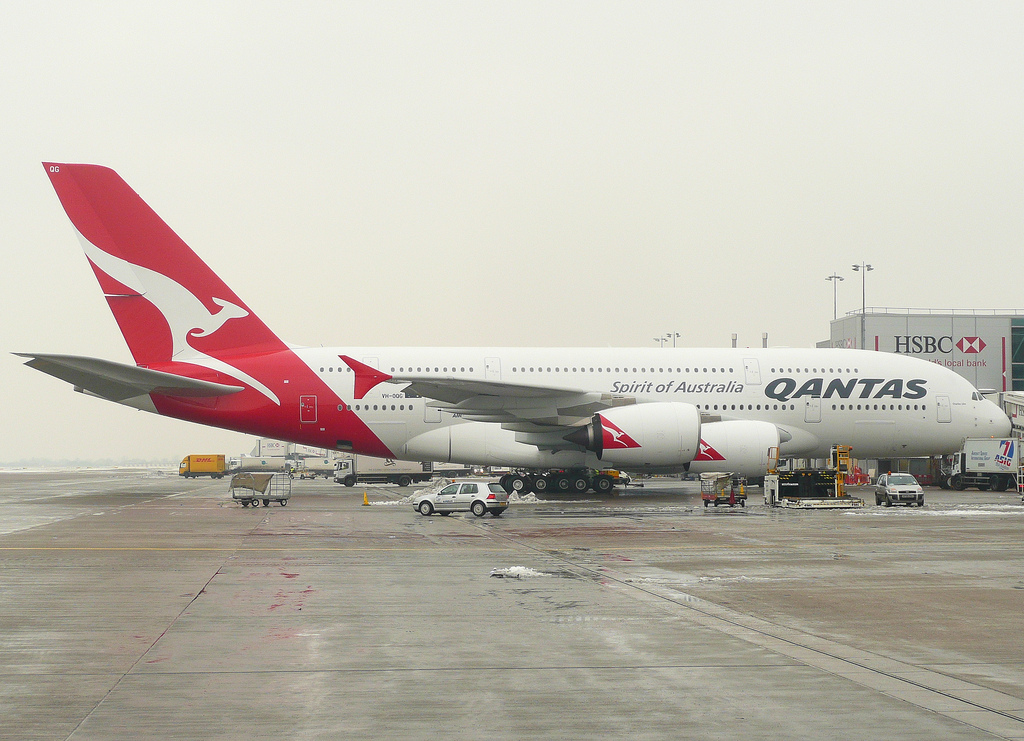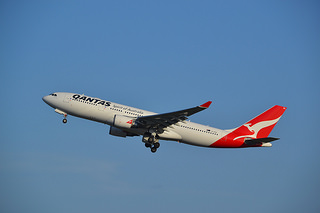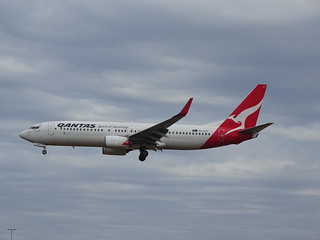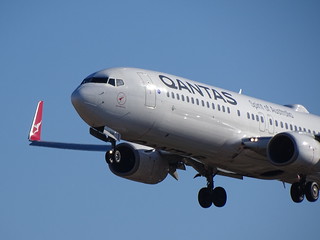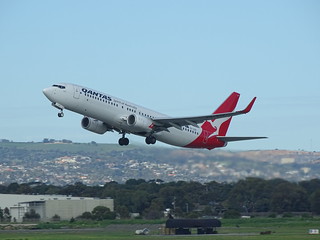Qantas A388 over Pacific on May 20th 2017, engine shut down in flight
Last Update: October 18, 2018 / 13:21:17 GMT/Zulu time
Incident Facts
Date of incident
May 20, 2017
Classification
Incident
Airline
Qantas
Flight number
QF-94
Departure
Los Angeles, United States
Destination
Melbourne, Australia
Aircraft Registration
VH-OQG
Aircraft Type
Airbus A380-800
ICAO Type Designator
A388
The airline reported the aircraft returned to Los Angeles due to operational reasons, subsequently added that one of the four engines lost power and was shut down.
On May 22nd 2017 the Australian Transportation Safety Board (ATSB) reported the engine #4 thrust reduced to about 45% while climbing through FL330. The flight crew shut the engine down and returned to Los Angeles. The ATSB rated the occurrence an incident and opened an investigation.
On Oct 18th 2018 the ATSB released their final report into the incident concluding the probable causes were:
- Internal corrosion of low-pressure turbine stage 2 blades resulted in fatigue failure and separation of blade debris and downstream damage through the engine.
- The blade corrosion resulted from chemical residue associated with the cleaning procedure used during the last engine service.
The ATSB described the sequence of events:
About two hours after departing LAX, the flight crew requested and received ATC clearance to climb to FL 340. The flight crew commenced the climb and increased the thrust on all four engines to 93 per cent ‘N1’4.
As the aircraft passed FL 325, the crew on the flight deck heard a loud bang and felt a sudden and unusual vibration of the aircraft, which reduced significantly after about 2 seconds. The first officer noticed No. 4 engine’s N1 was much lower than the other three engines – at about 49 per cent (although the flight data showed about 71 per cent N1). The captain, who was in the crew rest area, heard the bang and felt the vibration so he returned to the flight deck.
Flight data showed that as the aircraft passed FL 325, the No. 4 engine intermediate pressure turbine experienced an overspeed and its N2 increased from 92 per cent to the redline limit of 98.5 per cent over the next 2 seconds. An electronic centralised aircraft monitoring (ECAM) ‘ENG 4 N2 OVER LIMIT’5 message and master warning appeared for 2 seconds.
The SO1 and first officer saw an ECAM message flash up but it disappeared before they could read it.
Shortly after, an advisory message (ADV) appeared on the engine warning display and 6 seconds later the message ‘ENG 4 NORM MODE FAULT’ appeared on the ECAM, along with the associated checklist, a single chime and illumination of the master caution. The ECAM message indicated that there was a problem with the full authority digital engine control (FADEC) of that engine. That fault was triggered by the automatic reversion of the FADEC of engine 4 to alternate mode, caused by the loss of air data or engine sensing parameters.
The flight crew actioned the ECAM first because it had a higher priority than the advisory message.
There were only two items on the ECAM checklist. The first required the flight crew to select the switch to set the FADEC to alternate mode for all engines. The second item was to set the autothrust as required (the autothrust was already at an appropriate setting). After completing those two actions, the ECAM message cleared and there were no other ECAMs at that stage.
The first officer received an interphone call from a cabin crewmember in the forward main galley reporting a bang and feeling vibrations. He then received a second interphone call from the cabin crewmember in the main economy galley, reporting that a passenger had seen flames and sparks coming from the right outboard engine.
As the flight crew finished actioning the engine 4 normal mode fault ECAM checklist, the captain arrived on the flight deck, about 60 to 90 seconds after he had heard the bang. The SO1 made the required callout to the first officer when the aircraft was 1,000 ft below FL 340, then swapped out of the captain’s seat. The first officer briefed the captain on the events, and the captain resumed the PF role from the left seat and the first officer became the PM.
The SO1 received multiple calls from cabin crewmembers advising that the aircraft was vibrating in an unusual way, and some had seen sparks and flames. The flight crew found this information very useful because at that stage they had no indication on the flight deck of engine fire.
The flight crew investigated the cause of the ADV message and found that the N1 vibration signal for engine No. 4 indicated 10 units, which was the maximum value.
At about 0724, the aircraft levelled off at FL 340 and the flight crew commenced the abnormal checklist for high engine vibration. According to the flight data, at 0726:17, the flight crew reduced the thrust on engine No. 4 to idle (then generating around 24 per cent N1).
At 0726:44, the engine fire warning ‘ENG 4 FIRE’ ECAM message displayed. The flight crew did not finish the high vibration checklist because the engine fire warning had the highest priority and the flight crew actioned the associated checklist. At 0727:02, the flight crew selected the No. 4 engine master switch off, then pushed the engine No. 4 fire button and discharged one fire retardant agent. The engine fire ECAM cleared.
With the No. 4 engine shut down, the flight crew discussed their options. The aircraft was short of the equal time point between Los Angeles and Honolulu and the weather at both airports was suitable for a diversion, so the crew decided to return to Los Angeles.
The SO1 spoke to the company (Qantas) maintenance watch about the aircraft’s status and to the integrated operations centre about the return to Los Angeles. He also sent a message via the aircraft communications addressing and reporting system (ACARS) advising the company of the engine fire and that they were returning to LAX. The first officer declared a PAN and requested ATC clearance to descend initially to FL 300 and later to FL 290, advising they had shut down an engine and required a diversion to LAX. Air traffic control cleared the aircraft to return to LAX, which was about 2 hours away.
With respect to not shutting the engine down due to vibrations the ATSB wrote:
The first officer indicated that unlike his experience of Boeing aircraft, where there was a hard limit for engine vibration, they did not get an ECAM generated for the high vibration. According to the captain, flight crew are trained to strictly adhere to ECAM protocols. The high engine vibration procedure was part of the abnormal procedures menu and not presented as an ECAM. Therefore, the FADEC ECAM had higher priority than the high vibration advisory, and the crew did not shut down the engine until the engine fire warning ECAM required this action.
The flight crew operating manual (FCOM) stated that the ECAM vibration advisory is mainly a guideline to monitor the engine parameters and does not call for an immediate engine shutdown. The FCOM also states that high N2 vibrations can occur with or without airframe vibrations and that flight crew should cross-reference other engine parameters in order to determine the required course of action.
Airbus provided the following rationale for the procedure to be followed by flight crew for engine vibrations:
- The advisory message blinks when there is an abnormal vibration, that is, when N1 or N2 exceed 5 units.•When the advisory illuminates, flight crew can check the associated ECAM Not Sensed procedure ENG HI VIBRATIONS, which recommends monitoring engine parameters and reducing thrust if possible to maintain vibration level below the advisory threshold.
- If vibration is still above the advisory threshold, the decision to shut down the engine is left to the crew – the checklist item states ‘ENG (AFFECTD) MASTER OFF…CONSIDER.’
The ATSB summarized the engineering inspection:
Initial engineering inspection of the No. 4 engine following the incident found damage to the low-pressure turbine blades. There was no visible indication of fire and the event was contained, such that there was no breach of the engine casing. There was minor damage to the right flap and flap fairing from debris exiting the rear of the engine.
and analysed:
A teardown of the engine found internally-corroded low-pressure turbine stage 2 (LPT2) blades. The corrosion led to fatigue cracking and subsequent release of blade shroud debris, resulting in significant downstream engine damage.
The corrosion resulted from chemical residue in the hollow blades from cleaning operations at the last service (July 2015). Consequently, Rolls-Royce conducted a thorough audit of cleaning operations and took additional safety action (see Safety action section).
Fire
The fire and overheat detection system was assessed in an attempt to determine the cause of the fire warning. No issues were identified and the fire/overheat detector assemblies were removed and returned to the vendor for further assessment.
The detector manufacturer identified wear in the unit that would have made it more sensitive to vibration and increase the chance of spurious warnings. Rolls-Royce assessed that it was very likely that the wear, coupled with the vibrations associated with this event, contributed to the spurious fire warning.
Following the event upon inspection of other engines 12 engines were identified as potentially being affected by the cleaning procedure and were removed. The ATSB wrote: "The European Aviation Safety Agency released Airworthiness Directive (AD) 2018-0121, effective June 2018, relating to the potential for blade corrosion due to residual cleaning contaminants. The AD mandated replacement of the affected blades in accordance with the Rolls-Royce NMSB RB.211-72-AJ933."
Aircraft Registration Data
Incident Facts
Date of incident
May 20, 2017
Classification
Incident
Airline
Qantas
Flight number
QF-94
Departure
Los Angeles, United States
Destination
Melbourne, Australia
Aircraft Registration
VH-OQG
Aircraft Type
Airbus A380-800
ICAO Type Designator
A388
This article is published under license from Avherald.com. © of text by Avherald.com.
Article source
You can read 2 more free articles without a subscription.
Subscribe now and continue reading without any limits!
Read unlimited articles and receive our daily update briefing. Gain better insights into what is happening in commercial aviation safety.
Send tip
Support AeroInside by sending a small tip amount.
Related articles
Qantas A388 near Perth on Dec 7th 2014, loss of cabin pressure
A Qantas Airbus A380-800, registration VH-OQG performing flight QF-2 from Dubai (United Arab Emirates) to Sydney,NS (Australia), was enroute at FL400…
Qantas B789 over Pacific on Apr 14th 2024, electrical problem
A Qantas Boeing 787-9, registration VH-ZNH performing flight QF-76 (dep Apr 13th) from Vancouver,BC (Canada) to Sydney,NS (Australia), was enroute at…
Qantas A332 at Perth on Mar 25th 2024, engine shut down in flight
A Qantas Airbus A330-200, registration VH-EBA performing flight QF-781 from Melbourne,VI to Perth,WA (Australia), was descending towards Perth when a…
Qantas B738 near Kalgoorlie on Oct 25th 2021, fuel imbalance and engine shut down in flight
A Qantas Boeing 737-800, registration VH-VZT performing flight QF-888 from Perth,WA to Adelaide,SA (Australia) with 88 passengers and 6 crew, was…
Qantas B738 and Qantas B738 at Sydney on Apr 29th 2023, loss of separation between go around and takeoff
A Qantas Boeing 737-800, registration VH-VZW performing flight QF-146 from Auckland (New Zealand) to Sydney,NS (Australia) with 100 passengers and 7…
Qantas B738 over Tasman Sea on Oct 19th 2023, radio failure
A Qantas Boeing 737-800, registration VH-XZF performing flight QF-142 from Auckland (New Zealand) to Sydney,NS (Australia), was enroute at FL360 over…
Newest articles
Red Air MD82 at Miami on Jun 21st 2022, runway excursion causes gear collapse on landing
A Red Air Dominicana McDonnell Douglas MD-82, registration HI1064 performing flight L5-203 from Santo Domingo (Dominican Republic) to Miami,FL (USA)…
Southwest B737 near Dallas on Apr 25th 2024, engine shut down in flight
A Southwest Airlines Boeing 737-700, registration N793SA performing flight WN-4195 from Denver,CO to San Antonio,TX (USA), was enroute at FL410 about…
Subscribe today
Are you researching aviation incidents? Get access to AeroInside Insights, unlimited read access and receive the daily newsletter.
Pick your plan and subscribePartner

A new way to document and demonstrate airworthiness compliance and aircraft value. Find out more.

ELITE Simulation Solutions is a leading global provider of Flight Simulation Training Devices, IFR training software as well as flight controls and related services. Find out more.

Your regulation partner, specialists in aviation safety and compliance; providing training, auditing, and consultancy services. Find out more.
AeroInside Blog
Popular aircraft
Airbus A320Boeing 737-800
Boeing 737-800 MAX
Popular airlines
American AirlinesUnited
Delta
Air Canada
Lufthansa
British Airways

